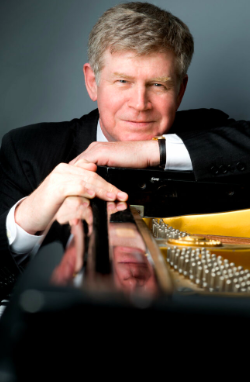SubCulture presents Ian Hobson: The Robert Schumann Cycle in Review
Ian Hobson, piano
SubCulture, New York, NY
February 19, 2020
Fantasy Pieces
Fantasiestücke, Op. 111
Fantasiestücke, Op. 12
Fantasia in C, Op. 17
Ian Hobson is a heroic completist. I admire the intellectual curiosity and physical stamina it takes to produce such investigations, for they allow us to perceive the larger context of a composer’s work, what I like to call the genetic resemblance among the works, what amounts to the personal fingerprint or style of that artist, possessed by no other.
Mr. Hobson kicked off his epic series exploring the complete solo piano music and piano-based chamber music of Robert Schumann on February 19th with an evening of ‘fantasy’ titled pieces. (Yes, I wish Schumann’s lieder were included in this series.) The word fantasie in German implies a free flight of the imagination, and this concept fueled so much of Schumann’s output, including pieces that don’t even bear such a title overtly. Interestingly, the pieces called fantasien are some of the most cogently structured in Schumann’s total oeuvre, usually three part A-B-A forms, often with codas of short or medium length.
Some general qualities of Hobson’s performance on this occasion, before I turn to details: He revealed the strength and architecture of every piece, through an unfussy approach. He didn’t automatically slow down the end of every phrase. He didn’t ‘perfume’ the music with a certain Victorian idea of ‘poetry.’ He didn’t treat the music like a museum piece, rather he plunged in with a headlong high energy that put things together.
I think Mr. Hobson performed as Master Raro, the third of Schumann’s personalities and the one who gets the least attention. Master Raro was the mediator between Florestan, the fiery impetuous soul, and Eusebius, the dreamy one. I sensed that Hobson identified with Florestan more, but then he’d do something so breathtaking, some little detail, often in a coda, that was sheer magic.
The recital began with the unjustly neglected late-period Fantasiestücke, Op. 111. Can we once and for all do away with the idea that late-period Schumann is the product of a feeble and disordered mind? The mind was doubtless wracked by mental illness, but it was far from feeble. These three pieces form an arch of sorts, with the most poignant one in the middle. The outer two are both in C minor, and they storm away, with distant references to Schumann’s detailed study of baroque counterpoint. In the middle work, which I regard as Schubert’s ‘seventh’ Moment Musical, the outer ‘A’ sections even resemble Schubert’s second Moment, with the same key, A-flat, and similar melodic rise and fall within a restricted compass. The reverie is interrupted by a contrasting agitated section that seems to reintroduce the first piece. Peace is regained however, and Mr. Hobson was perfect in portraying the calm resolution.
Mr. Hobson was at his finest in the large set of Fantasiestücke, Op. 12. Most of these are well-known, ‘or are they?’ When music becomes iconic, there is a danger of not really listening after the first few notes are played. We think we’re plugged in, but we’re really playing our own soundtrack. Mr. Hobson did not allow such an automatic reaction. Through a combination of strength and delicacy, he showed perhaps what the music sounded like two hundred years ago, when Clara Schumann was constantly begging Robert to compose something ‘a bit less difficult’ for her audiences to grasp.
Mr. Hobson’s rendition allowed me to perceive the frightful toll of undiagnosed bipolar illness, the sudden, violent contrasts between manic energy, unbounded creative confidence, followed by the horrifying plunges into dark chasms of depression from which one thinks one will never emerge. The headlong abandon with which Hobson launched into the Traumeswirren (Dream-Confusions) was truly terrifying and well worth the few dropped notes here or there. Again, I noticed all the codas, which simply melted into reflective contentment. What an achievement!
After a brief intermission came the Fantasie, Op. 17, omnipresent on so many recitals. This work was initially projected as part of the fund-raising effort for a Beethoven monument in Bonn, with Franz Liszt (dedicatee of the work) the prime instigator. The movements once had programmatic titles, and a prominent quotation from Beethoven’s An die ferne Geliebte song cycle (To the Distant Beloved) forms the conclusion to the first movement (once also found at the end of the third movement, which Mr. Hobson I think wisely chose not to play—he stuck to the traditional ending).
Since Schumann and Clara were forbidden by her father to see each other, he communicated with her through music that was mailed, often containing the famous Clara cipher, usually six descending notes. The Fantasie is preceded by an epigram from Schlegel: “Through all the tones resounding/In the many-colored dream of life/A softer tone sounds/For the one who knows secretly how to listen.” Again, the coded conversation is stunning.
Mr. Hobson’s approach was brisk and orchestral. The fearsome coda to the second movement’s march almost got away from him, but the sense of risk was palpably worth it. Many virtuosi won’t end an entire program with the work, because of the quiet ending. Thank goodness Mr. Hobson can’t be bothered with such silliness. He returned us to the dream-state we need, and now we can’t wait to hear the sequel(s) of his devotion to the rest of Schumann.
Mr. Hobson favored his appreciative audience with an encore by Chopin that was nicknamed by Schumann “The Aeolian Harp” (Etude Op. 25, No. 1), referring to a mythical Greek instrument played by the wind, whose modulations depended on the strength of the breeze. Recall what Schumann’s dreamy side, Eusebius, said about Chopin in 1831: “Hat’s off, gentlemen! A genius!” regarding the latter’s variations on Mozart’s “La ci darem la mano” for piano and orchestra.

